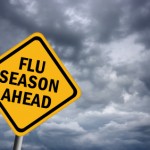Like we always do, we got our flu shots early, this year on the day after they first became available. Several friends said they were going to wait a few months; I'm always concerned that the supply of vaccine will be gone by then and as former Air Force medical staff, we got in the habit of being told, "It's time for your flu shot." Our timing was excellent; flu struck earlier than usual (it typically peaks in February). And the New York State Department of Health agreed that the best time to get a flu shot is as soon as the vaccine is available.
This is a bad flu season with not only an early peak in case numbers, but also an unusual virus. I looked at the flu primer, updated for the 2012-2013 season, by arstechnica, a technology news and information website. The influenza virus has an outer layer of proteins around its genetic material core; the specific proteins of the coating determine what kind of cells the flu bug can attach to and therefore infect (they also act as chemicals that our immune system can react to), while the inside core lets the virus take over the cell and make new viral particles.
The most important proteins in the outside coating are called hemagglutinin (H) and neuraminidase (N); there are a variety of each with the CDC saying there are 16 different Hs and 9 Ns. Three variants, H1N1, H1N3 and H3N2, are currently infecting humans while the highly pathogenic H5N1 avian flu was of major concern in recent years. As of January 5th, 2013, the influenza A H3N2 virus was the predominant strain causing flu in the United States.
There are three types of influenza viruses, logically enough labeled types A, B and C. Type A can affect both humans and some animals and is responsible for the largest and most widespread outbreaks termed pandemics. Type B only occurs in people and usually is responsible for less severe reactions; it is not classified by subtypes and isn't responsible for pandemics. Type C, also only a human strain, doesn't cause epidemics, much less pandemics and doesn't lead to severe illness. The yearly vaccine protects against two type A strains (H1N1 and H3N2) and one type B virus with specific viruses chosen based on scientific estimations of what the coming year's flu will most likely be. The CDC webpage titled "Key Facts about Seasonal Flu Vaccine" mentions three different flu shot varieties and one nasal vaccine; the shots are all made from inactivated viruses (one is a high-dose form designed for those of us 65 and older). The nasal spray is made from live attenuated (weakened) viruses and can be given to anyone age 2 to 49 who is not pregnant and is otherwise healthy.
Now civilian hospitals in a number of areas have fired staff members who refused to get vaccinated for influenza. Some of those former hospital employees are threatening to sue, but my own viewpoint is the hospitals have done the right thing. The last thing I think they need is their own docs, nurses, techs and other staff infecting patients who are already ill with something that may make them more likely to have flu complications.
What about pregnant women who work for the hospital? Should they get flu shots or does that place their fetuses at risk? I wasn't sure until I saw the 1-16-2013 edition of the New England Journal of Medicine. A Norwegian study performed during the 2009 flu pandemic had convincing figures: there were 117,347 eligible pregnancies and 54% of the women were vaccinated in their second or third trimester with substantial reduction in moms getting the flu.
Pregnant women in this study who did have influenza had an increased risk of fetal death. Vaccination did not increase fetal mortality (and may actually have reduced it).
The real problem with bad cases of flu is bacterial coinfection, often with "bugs" that colonize our nasopharynx area: staph aureus, strep pneumoniae and strep pyogenes. This highly significant flu complication was present in almost everyone who died in the great flu pandemic in 1918 and, even today, with our panoply of antibiotics, frequently occurs in influenza victims who require ICU care. A third of those needing such intensive care in the 2009 H1N1 pandemic had such a combined illness.
The CDC has a superb webpage, "What you should know for the 2012-2013 Influenza Season," and I strongly recommend using that as a source.
Here's hoping you get a yearly vaccination and don't ever get the flu.















